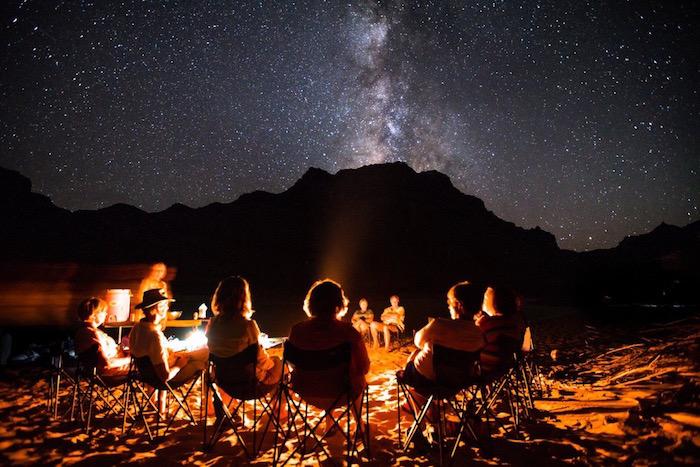
Our small group seemed to have the starry backcountry of Canyonlands National Park all to ourselves this fall/Bill Church
Two of the greatest backcountry trips I had this year involved float trips in Dinosaur National Monument and Canyonlands National Park in Utah. Why? The solitude. Outside of our own small groups, it was as if we had the parks to ourselves.
Were you able to find solitude on your backcountry trips this year? Glancing through the backcountry use statistics for the National Park System, it looks like some parks saw quite a few backpackers, paddlers, and floaters this year. For instance:
* Yosemite National Park in California, through November recorded an increase of 22,231 backcountry travelers over the same period for 2014. Year-to-date, the park had counted 212,023 backcountry travelers.
* Voyageurs National Park in Minnesota reported an increase of 18,521 through November, with a year-to-date total of 50,462. (2014 backcountry travel in the park was hindered by flooding).
* Olympic National Park staff in Washington state said there has been an increase of 18,755 backcountry travelers through November, bringing the year-to-date tally to 88,095.
* Point Reyes National Seashore in California reports an increase of 12,550 backcountry users, for a year-to-date total of 55,140.
* Great Smoky Mountains National Park in North Carolina and Tennessee shows an increase of 10,448 backcountry travelers, for a year-to-date total of 94,852.
A number of parks showed decreases, as well, some quite staggering. For instance, Grand Canyon National Park in Arizona through November reported a decrease of 83,054 backcountry users. On its face that seems incredible, though Park Service statisticians say the big decline most likely reflects a lack of data for the fall months, not a mass flight from the backcountry.
While the Park Service stats show an overall 2 percent decline in backcountry travel for the year through November, that number likely will change by the time the official 2015 statistics are available in February.
Unfortunately, the Park Service stats don't indicate who is using the backcountry. But there are theories that not all the users are Baby Boomers, and that more than a few are Millennials.
"They (Millennials) have interests. Backcountry was made for them. We hear this anecdotally all the time," says Jeff Olson, a Park Service spokesman at the agency's Washington, D.C., headquarters.
A grad student report a couple years ago, he went on, indicated that Milliennials "wanted to mountain bike, they wanted to bungee jump. The message that day was extreme sports. They love to go backpacking and hiking and camping, and they don’t want to be in a campground with a bunch of other people.
“I remember being 18 and getting out of school," continued Mr. Olson. "I rode my bicycle on a trip for 1,500 miles. It was wonderful. I had classmates who went to Glacier to backpack. ...This generation is like a lot of others. They’re immortal. They really care about the outdoors and the environment. They want to make a difference. They don’t want to be told what to do.”
That said, there's still a need to introduce the younger generations to backcountry travel in the national parks, according to Great Smoky Superintendent Cassius Cash.
"I think the Find Your Park thing is not about the amount of people that come, but it’s the diversity of people that come, and it’s particularly aimed at the next generation. I think we need to aim at that, and people that we're introducing to the natural world," he said during a recent phone call.
Surprising to Baby Boomers, perhaps, but many urban youth are intimidated by going deep into the woods, said the superintendent. While Baby Boomers had television programs that introduced them to nature and wild settings, many of today's youth seem focused on video games and social media channels that don't offer the same connections.
“Those outdoor shows, back in my time it was Mutual of Omaha’s Wild Kingdom, where it tapped into my imagination to be in different continents from week to week," Superintendent Cash said. "Most kids (today) don’t sit down and watch that. It’s all about Xboxes and phones and all of those kinds of things that are competing for time.
"... I know personally the first time I went turkey hunting, the first time I ever did something that was new, it was always wth someone that I trusted and that would show me the ropes. And I think there’s a generation of kids that just want you to do the same for them, and not just say, 'Hey, go out there and good luck and have fun.'
“It’s about how do you usher them into this where you can take whatever the unknowns are out of their equation and allow them a choice to whether they want to continue to do that or not.”



Comments
The people who believe the pristine nature should be preserved should be very concerned with this trend. Visitation is way up overall but backcountry use is down. If that continues, there will be ever increasing pressure to expand the front country experience at the expense of the backcountry.
BS. Unmitigated BS.
We have dozens of documented backcountry nights where the NPS reservation system is showing full only to have NO ONE in the site. The NPS is monkeying with numbers and padding them to offset negative press about reservation systems and new fees. To listen to the NPS they would have you believe that fees increase use of the backcountry. It does not. That is why watchdog groups have to independently audit NPS padded numbers. I have experienced it first hand last weekend and several weekends this past year.